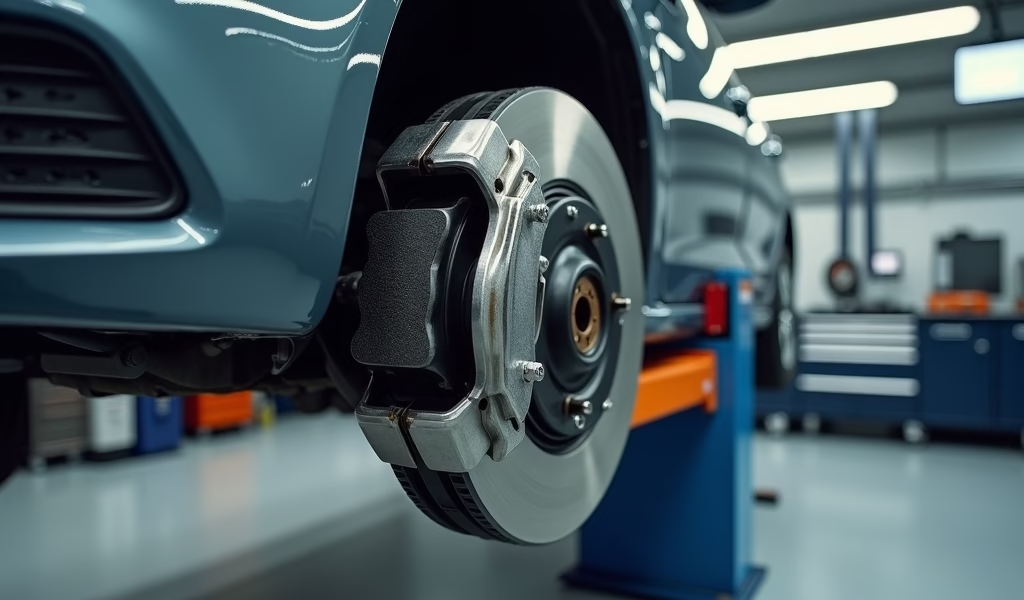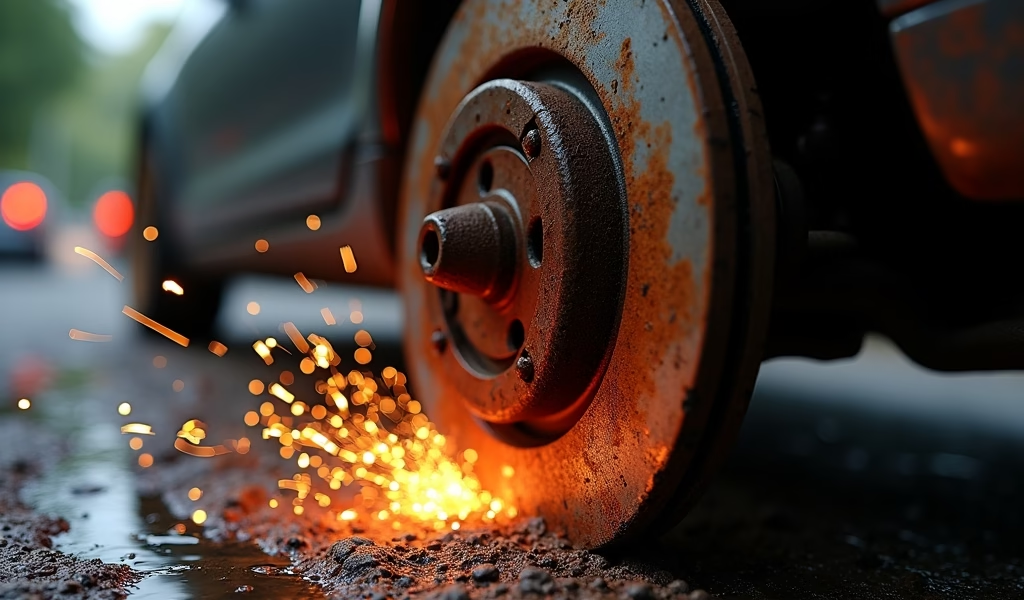Overview
Brake pad replacement typically costs $150-$300 per axle, varying based on vehicle type, pad material (from budget organic to premium ceramic), location, and whether additional components need replacement. Extending pad lifespan involves gentle driving habits, regular inspections, and preventative maintenance, while saving money requires comparing shops, requesting OEM-equivalent parts, bundling services, and timing replacements strategically.
Table of Contents
- Understanding Brake Pads: The Unsung Heroes of Your Vehicle
- 5 Tell-Tale Signs Your Brake Pads Need Replacement
- Breaking Down the Average Brake Pad Replacement Cost
- Key Factors That Influence Your Brake Pad Replacement Bill
- DIY vs. Professional Replacement: What’s Right for You?
- Top 5 Secrets to Save Money on Brake Pad Replacement
- How to Extend the Lifespan of Your New Brake Pads
- Conclusion
- Frequently Asked Questions
Understanding Brake Pads: The Unsung Heroes of Your Vehicle
When it comes to brake pad replacement cost, there’s more than meets the eye (or wallet). As a mechanic who’s replaced thousands of these critical components, I can tell you that brake pads are the unsung heroes of your vehicle’s safety system. They’re the sacrificial lambs that wear down so your rotors don’t have to!
Think of your brake pads as the middlemen in a high-stakes negotiation between your foot and your vehicle’s momentum. Every time you press that brake pedal, these humble components convert kinetic energy into heat through friction, bringing your 4,000-pound metal chariot to a safe stop. Pretty impressive for something smaller than a smartphone, right?
Brake pads typically consist of a steel backing plate with friction material bound to the surface that contacts the brake rotor. This friction material varies widely—from organic compounds to metallic mixtures to ceramic formulations—each with their own performance characteristics and, you guessed it, different price points that affect your overall brake pad replacement cost.
Most modern vehicles use disc brakes at least on the front wheels, which work like the brakes on a bicycle. When you hit the brakes, hydraulic pressure pushes the brake pads against a rotor (a disc attached to the wheel), creating friction that slows the vehicle. It’s a beautiful dance of physics that we take for granted every day!
5 Tell-Tale Signs Your Brake Pads Need Replacement
Before we dive into the dollars and cents of brake pad replacement cost, let’s talk about how to know when these crucial components are waving the white flag. Your vehicle has ways of crying for help when brake pads are wearing thin—and trust me, this is one mechanical plea you don’t want to ignore!
The most obvious indicator is that high-pitched squealing sound that makes your skin crawl. That’s not your car singing opera—it’s a small metal indicator (aptly called a “wear indicator”) designed to make contact with the rotor when your pads have worn down to a critical level. It’s like your car’s way of saying, “Hey there! A little help, please?”
Here are the top 5 signs it’s time for new brake pads:
- Screeching or squealing noises when braking (the aforementioned wear indicator doing its job)
- Grinding sounds (metal-on-metal contact—you’ve waited too long!)
- Vibration or pulsation in the brake pedal during braking
- The brake warning light illuminating on your dashboard
- Visibly thin brake pads (less than ¼ inch of pad material remaining)
If your vehicle takes longer to stop than it used to, that’s another red flag waving frantically in your face. Your brakes aren’t just underperforming—they’re underprepared for emergency situations. And in my two decades as a mechanic, I’ve seen too many close calls from drivers who tried to squeeze a few more miles out of worn pads.
Remember, your brake system doesn’t get better with age like fine wine—it deteriorates with use like, well, brake pads! Ignoring these warning signs not only increases your eventual brake pad replacement cost but puts you and others at risk. Safety first, savings second!

Breaking Down the Average Brake Pad Replacement Cost
Let’s talk turkey about brake pad replacement cost—the numbers that make wallets wince. According to AAA’s automotive research, the average brake pad replacement cost ranges from $150 to $300 per axle. But like a custom-built hot rod, your actual price tag can vary significantly based on multiple factors.
This cost typically breaks down into two main categories: parts and labor. The parts—brake pads themselves—can range from $30 for budget options to over $100 for premium ceramic pads per axle. Labor typically runs between $80 and $200 per axle, depending on your location and the shop’s hourly rate. It’s like paying for both the actor and the director in this automotive performance!
Here’s a quick breakdown of what you might expect to pay based on vehicle type:
- Economy cars: $150-$250 per axle
- Mid-size sedans/SUVs: $200-$300 per axle
- Luxury vehicles: $300-$450+ per axle
- Performance vehicles: $350-$500+ per axle
Many shops offer brake specials or package deals, especially during slow seasons. These can be great opportunities to save on your brake pad replacement cost, much like catching that winter coat on an end-of-season sale. Keep your eyes peeled for these deals—your wallet will thank you!
Remember, these figures assume you’re only replacing the brake pads. If your rotors need resurfacing or replacement (often necessary after driving too long on worn pads), you’re looking at an additional $100-$300 per axle. And if your calipers have seen better days? Tack on another $100-$300 each. The brake system is a team sport—one weak player affects the whole lineup!
Key Factors That Influence Your Brake Pad Replacement Bill
When it comes to brake pad replacement cost, there’s more variance than flavors at an ice cream shop! As someone who’s worked on everything from economical compacts to high-performance exotics, I can tell you that several key factors determine whether your bill will be a minor bump or a major pothole in your monthly budget.
Vehicle make and model plays perhaps the biggest role in your final cost. It’s like comparing a hamburger at a local diner to one at a five-star restaurant—same basic concept, wildly different pricing! European luxury vehicles like BMW or Mercedes-Benz typically command higher parts prices and often require specialized tools or expertise. Their brake pad replacement cost might be 2-3 times that of a Honda or Toyota.
Brake pad material is another significant cost driver. Here’s how they stack up:
- Organic pads ($30-$50): The economy option, suitable for normal driving but wear faster
- Semi-metallic pads ($40-$80): Better performance and longevity, but can be noisy
- Ceramic pads ($70-$150): Premium choice with minimal dust and noise, longer lifespan
- Performance/specialty pads ($100-$300): For high-performance vehicles or specific driving conditions
Your geographic location also plays a surprising role in your brake pad replacement cost. Labor rates in Manhattan might give you sticker shock compared to the same job in rural areas. It’s the automotive equivalent of real estate—location, location, location!
Don’t forget about shop type. Dealerships typically charge premium rates for their factory-trained technicians and OEM parts, while independent shops might offer better value. Chain repair shops often fall somewhere in the middle, with standardized pricing and frequent specials. It’s like choosing between a boutique hotel, a vacation rental, or a chain hotel—each has its pros, cons, and price points.
Additional repairs often sneak into the final bill, too. When your mechanic gets those wheels off and really examines your brake system, they might discover worn rotors, leaky calipers, or damaged brake lines. Remember, a thorough inspection now can prevent a costly breakdown (or worse, an accident) later!
DIY vs. Professional Replacement: What’s Right for You?
The age-old question that makes mechanics everywhere hold their breath: “Should I just do this brake job myself?” When considering brake pad replacement cost, the DIY route certainly looks tempting on paper. The parts alone might cost $30-$150 per axle, potentially saving you $100-$200 in labor costs. But before you rush to YouTube University for your brake repair degree, let’s weigh the pros and cons!
DIY brake pad replacement can be a reasonable project for the mechanically inclined with proper tools and workspace. It’s like making your own pasta from scratch—satisfying when done right, but with a learning curve and potential for mess! You’ll need basic tools like jack stands, wrenches, C-clamps, and possibly specialized tools depending on your vehicle. Safety is paramount—never work under a car supported only by a jack!
Here’s what you should consider before going the DIY route:
- Do you have experience with automotive repairs?
- Do you have a safe workspace with proper tools?
- Do you have access to quality parts and proper disposal for old ones?
- Can you confidently bleed brakes if needed?
- Do you have a backup transportation plan if things go sideways?
Professional brake service, while more expensive upfront, comes with significant advantages. Professional mechanics don’t just replace pads—they inspect the entire brake system, identifying potential issues before they become problems. They have specialized tools, proper disposal methods for hazardous materials, and the expertise to handle complications. Plus, most shops offer warranties on both parts and labor.
Think of it this way: DIY brake work is like cutting your own hair—possible with the right tools and skills, but with real consequences if things go wrong! Your brakes are literally your vehicle’s most important safety system. If you’re unsure, the peace of mind from professional installation might be worth the additional brake pad replacement cost.

Top 5 Secrets to Save Money on Brake Pad Replacement
After 20+ years turning wrenches, I’ve seen customers pay way more than necessary for brake service. Let me share my insider secrets to keep your brake pad replacement cost reasonable without compromising safety. These aren’t just penny-pinching tips—they’re smart ownership strategies!
Secret #1: Don’t automatically default to the dealership. While they excel at specialized knowledge for your specific make, independent shops often offer comparable quality at lower prices. Look for ASE-certified technicians who specialize in your vehicle type. It’s like finding that amazing neighborhood restaurant that serves food as good as the fancy place downtown, but at half the price!
Secret #2: Request OEM-equivalent parts rather than dealer parts. Many aftermarket parts meet or exceed original equipment specifications at a fraction of the cost. Brands like Wagner, Raybestos, or Akebono offer excellent quality without the premium pricing. This alone can save you 20-30% on your brake pad replacement cost.
Secret #3: Bundle your brake service with other maintenance. Many shops offer discounted labor rates when performing multiple services at once. Need an oil change and tire rotation too? Combining services means the technician only needs to remove the wheels once, saving time and money. It’s the automotive equivalent of buying in bulk!
Secret #4: Regular brake inspections can prevent costly emergency repairs. Having your brakes checked during routine maintenance can catch wear issues early, before they damage expensive components like rotors and calipers. As we say in the shop, “An ounce of prevention is worth a pound of brake pads!”
Secret #5: Consider timing your replacement strategically. Many shops offer seasonal specials on brake service—particularly during slower business periods or during car care months. Spring and fall often bring brake specials as shops prepare customers for summer road trips or winter driving conditions. Sign up for your preferred shop’s email list to catch these promotions!
Remember, the goal isn’t just to minimize your brake pad replacement cost—it’s to maximize value. Sometimes paying slightly more for better quality pads means they’ll last twice as long, saving you money in the long run. Think marathon, not sprint, when it comes to brake maintenance!
How to Extend the Lifespan of Your New Brake Pads
After you’ve invested in that brake pad replacement, wouldn’t it be nice to postpone the next one as long as possible? The good news is that with some mindful driving habits, you can significantly extend the life of your brake pads and spread out that brake pad replacement cost over more miles. It’s like making your favorite shoes last longer—a little care goes a long way!
The single most effective way to extend brake pad life is to adjust your driving style. Aggressive braking—those dramatic, last-second stops—creates excessive heat and accelerates wear. Instead, practice the “coasting approach” to stops. When you see a red light ahead, ease off the accelerator early and coast before applying brakes gently. This technique alone can double your brake pad lifespan!
Here are more pro tips to maximize your brake pad investment:
- Reduce excess weight in your vehicle—every 100 pounds increases braking load
- Use engine braking by downshifting when approaching stops (especially effective on downhill stretches)
- Maintain proper following distance to avoid panic stops
- Flush brake fluid every 2-3 years to prevent system contamination
- Address any brake system issues immediately—that minor squeal could indicate uneven wear
Did you know that traffic patterns significantly impact brake wear? If possible, adjust your commute to avoid stop-and-go traffic. According to research from the Society of Automotive Engineers, highway driving can result in brake pads lasting up to three times longer than those subjected to constant city driving. It’s like choosing the express lane for your brake pads’ lifespan!
Regular maintenance checks are also crucial. Have your brakes inspected during tire rotations (typically every 5,000-7,000 miles). This allows technicians to check for uneven wear patterns that might indicate alignment issues or stuck calipers. Catching these problems early prevents premature wear and helps avoid that brake pad replacement cost for many more miles.
Remember that brake pad lifespan varies significantly by vehicle and driving conditions. Economy cars with lighter weight may get 40,000-60,000 miles from a set of pads, while heavier SUVs might need replacement at 30,000 miles. Performance vehicles driven enthusiastically might need new pads in as little as 15,000 miles—the price of performance is paid in brake pad longevity!
Conclusion
Understanding brake pad replacement cost doesn’t require an engineering degree—just some straight talk from someone who’s been elbow-deep in brake dust for decades. Whether you’re facing the squeaky reality of worn pads now or planning ahead for future maintenance, knowledge is your best tool for making sound decisions about this critical safety system.
Remember that brake pad replacement isn’t just a maintenance expense—it’s an investment in your safety, your passengers’ security, and your vehicle’s overall health. Trying to squeeze a few extra months out of worn pads can lead to more expensive repairs down the road when rotors and calipers join the replacement party.
The secrets we’ve uncovered today—from choosing the right shop and parts to driving techniques that extend pad life—can help you navigate brake service with confidence. The goal isn’t always to find the absolute lowest brake pad replacement cost, but rather the best value that balances quality, safety, and longevity.
Your braking system works incredibly hard every day, converting kinetic energy to heat through friction to keep you safe. Treat it with the respect it deserves, and it will return the favor with reliable performance when you need it most—like when that distracted driver suddenly stops in front of you or when a child chases a ball into the street.
So the next time you hear that telltale squeal, don’t turn up the radio—schedule that brake service! Your future self will thank you, both financially and for arriving safely at your destination. After all, the most expensive brake job is the one you need after waiting too long!
Frequently Asked Questions
How often should brake pads be replaced?
Most brake pads last between 30,000 and 70,000 miles depending on driving habits, vehicle type, and pad quality. Have them inspected during regular maintenance and replace them when they reach approximately 3-4mm thickness.
Can I replace just one set of brake pads if the others are still good?
While possible, it’s recommended to replace brake pads in axle pairs (both front or both rear) for balanced braking performance. Uneven braking forces can lead to handling problems.
Do premium brake pads really last longer than budget options?
Yes, premium brake pads typically last 20-40% longer than economy options and often provide better performance. The higher upfront cost usually results in better value over time.
How long does a brake pad replacement typically take?
A professional brake pad replacement usually takes 1-2 hours per axle. DIY replacements may take 2-4 hours depending on experience and equipment.
Is it dangerous to drive with worn brake pads?
Yes, worn brake pads significantly increase stopping distances and can damage rotors, leading to expensive repairs. Severely worn pads can cause brake failure in emergency situations.


Pingback: How Much Should It Cost to Replace Brake Pads and Rotors? - knowsyourcar.com